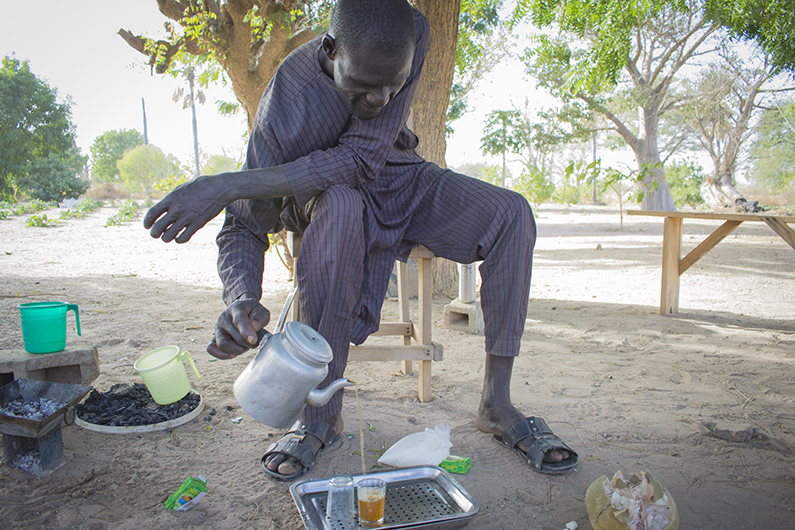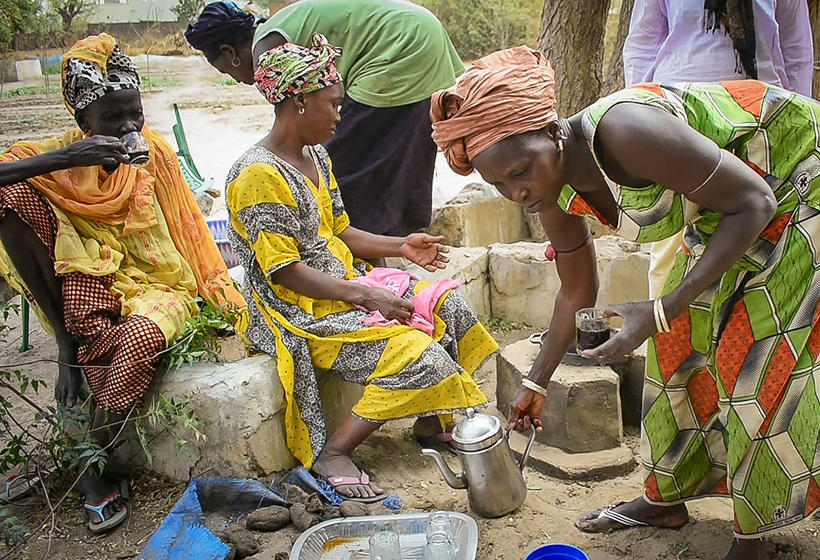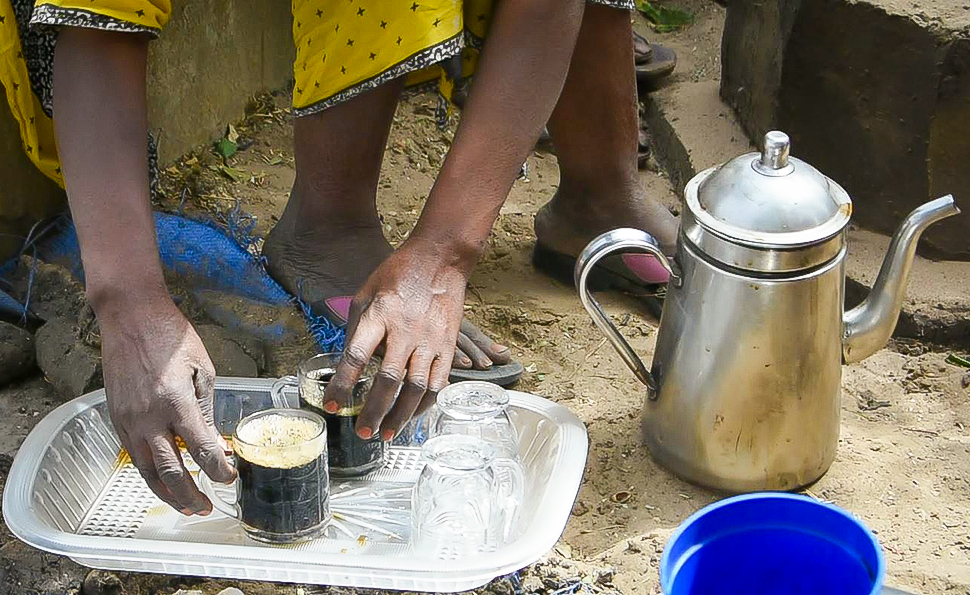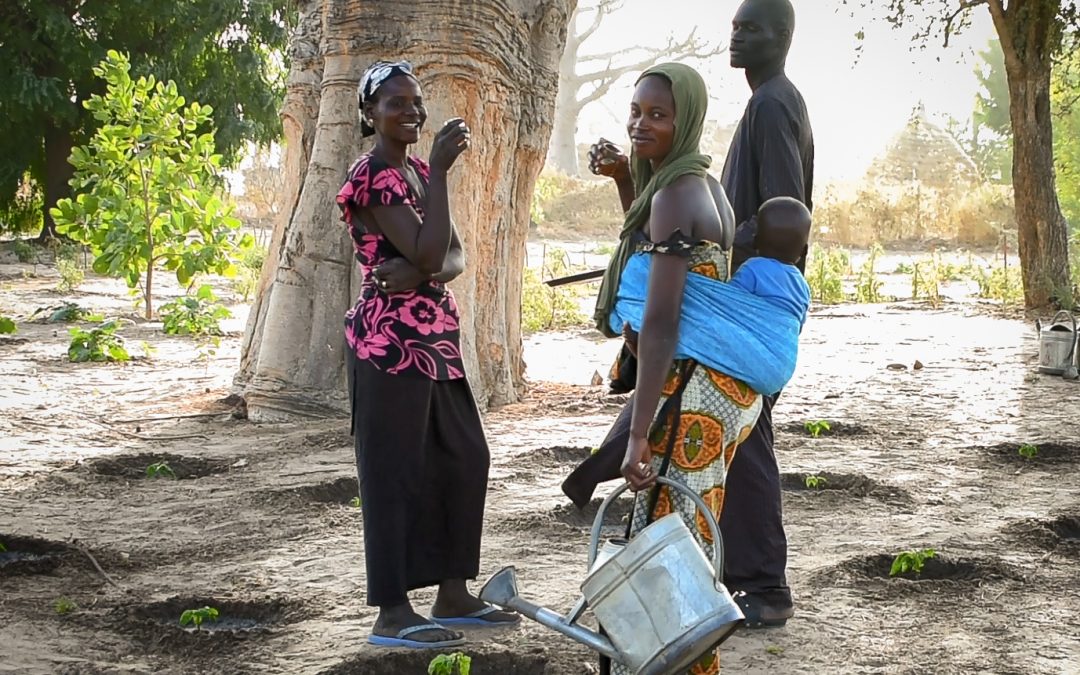Teranga, or hospitality, is at the heart of Senegalese culture. From the larger cities to smaller rural villages, you’ll find Teranga across every household and community. Chef Pierre Thiam said in a New York Times article, “Teranga is about the way we treat our guests. It’s about the way that when you come into a Senegalese household, everyone moves so that you can fit in the circle and share their food and drink.” In the spirit of the holidays and Senegalese Teranga, we’d like to share a delicious Senegalese drink with you to enjoy and warm up with this winter. Below you’ll find stories and recipes for the Senegalese drinks: Attaya tea and Café Touba.
Senegalese Drink: Attaya Tea

It’s 4:30 pm, and the hot desert sun is finally starting to sink lower into the sky. It casts long shadows and golden light across the cooperative community garden in the village of Walo. Women chat and laugh with one another as they clear weeds and leaves from their garden beds before filling watering cans at the basins and watering their thirsty crops.
While they work, a volunteer from the cooperative prepares “attaya,” a strong, sweet, minty tea, out in the garden. Attaya is a vital and vibrant part of daily Senegalese culture. You’ll find it is made and served almost anywhere you go, any time of day.
Attaya is made from Chinese gunpowder green tea, mint, and sugar, brewed in three stages in a kettle over hot coals. The tea is brewed strong and bitter, and then poured into tiny glasses called kas. It is then poured back and forth from glass to kettle and back again, to create a thick foam on top. The higher up you pour from and the thicker the foam, the better.
The Three Phases of Life
Friends share this first glass of tea, called lewel. After adding more sugar and mint, or nana, to the teapot, the process begins again for a second (naarel) round of tea. The third (nettel) round is the sweetest of all. There are several interpretations of the ritual’s symbolism. Still, many people say that the three concoctions are representative of the stages of life. The first stage is bitter, representing the difficulties of growing and early life. The second stage is sweeter, representing mid-life, love, and family. The third stage is the sweetest to symbolize the sweetness of old age. Other interpretations suggest that the three concoctions of attaya also represent the growing and sweetening of friendship over time.
Drinking the attaya, they can take a break from their work, enjoy the sweet treat, and get a little boost of energy from the sugar and tea! You could walk into any garden site across CREATE!’s partner communities, and see the same ritual taking place. This a beautiful symbol of the rich cultural traditions that make Senegal such an incredible place.
Senegalese Drink: Café Touba

Improved cookstoves can be found in almost any household in CREATE!’s partner communities. However, did you know that you can also find improved cookstoves throughout their community gardens as well? These improved cookstoves are used to make café Touba, a popular coffee beverage that is consumed by people of all ages, almost any time of day. A volunteer in the garden site will often prepare cafe Touba on an improved cookstove while the others work and bring it out to them in small cups to provide motivation and a short break from their tasks.
Café Touba History
The coffee is named after the Senegalese holy city of Touba, which is about an hour and a half north of CREATE! headquarters in Gossas. In Arabic, Ṭūbā means happiness or blessedness. The drink was introduced to Senegal and made popular by Islamic spiritual leader Cheikh Amadou Bamba Mbacké when he returned from exile in Gabon in 1902. Today, it is sold on street corners and in markets, and shared among family and friends.
Much like attaya tea, café Touba is brewed strong and sugary sweet. However, unique from other coffee beverages, it is made with cloves and Guinea pepper (or djar in Wolof), dried fruit from the aromatic and medicinal Xylopia aethiopica tree. The coffee has a sharp, sweet and spicy flavor, and is a great refreshment in the afternoon.

Volunteers prepare café Touba on an improved cookstove in their community garden sites to serve to cooperative members to boost their motivation and energy while they work.
How to make café Touba:
1. Roast 100g (3.5oz) of green Robusta coffee beans together with 10g (.35 oz) djar* and 10g (.35 oz) cloves in a metal pan until they have a nice, evenly dark color.
2. After cooling, grind in a mortar or a coffee grinder.
3. Bring 800 ml (28 oz) of water to the boil.
4. Place 4 tbsp of the coffee powder into a filter over a pot.
5. Pour the boiling water carefully through the filter into the jug and let it drain completely.
6. Repeat 2-3 times and add plenty of sugar to taste.
7. Serve hot and enjoy!
*If you don’t have access to djar, you can substitute a mix of half-black pepper, half-cardamom for a similar flavor.
Recipe from:
• http://www.lavazza.com/en/coffee-passion/training-center/history_coffee/curiosity/senegal.html
• http://bunaa.de/en/senegal-2/

